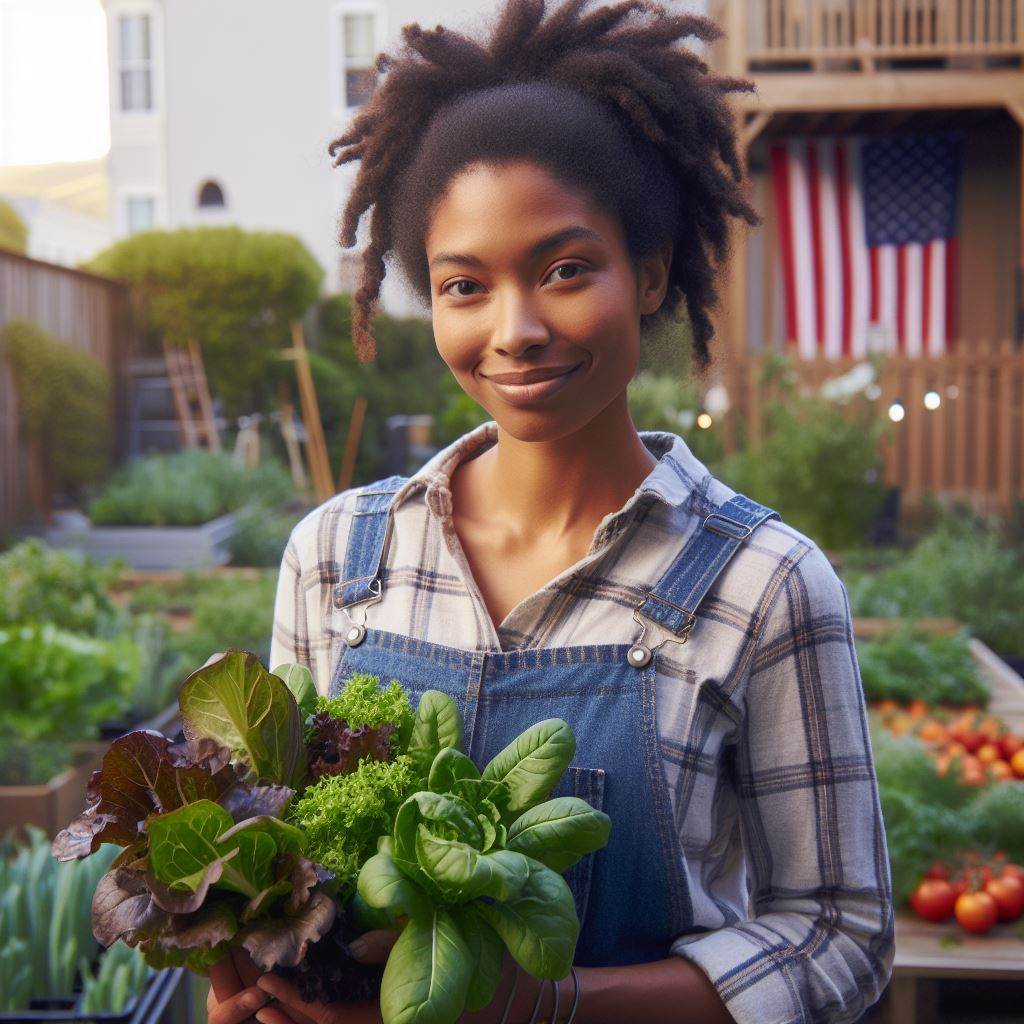Introduction
SF Urban Farming Startup In this blog section, we will explore the vibrant and rapidly expanding urban farming scene in San Francisco.
Urban farming refers to the practice of cultivating and growing food in urban areas.
It plays a crucial role in promoting sustainability, food security, and community engagement.
San Francisco has witnessed a remarkable growth in urban farming initiatives in recent years.
With limited space and increasing demand for fresh and locally sourced produce, residents and entrepreneurs have embraced urban farming as a viable solution.
This has led to the emergence of numerous startups and community gardens across the city.
Throughout this blog section, we will delve into the various aspects of San Francisco’s urban farming scene.
We will explore the challenges and opportunities faced by urban farmers, highlight innovative techniques and technologies being employed, and shed light on the impact of urban farming on the local economy and food system.
Additionally, we will showcase some of the successful urban farming startups and their unique approaches to sustainable agriculture.
From vertical farming and rooftop gardens to aquaponics and hydroponics, these startups are revolutionizing the way food is produced and consumed in the city.
Join us on this journey as we uncover the thriving urban farming culture in San Francisco and its positive implications for a greener and healthier future.
Stay tuned for the upcoming section where we will delve deeper into the various facets of this fascinating startup story.
The rise of urban farming in SF
Historical background of urban farming in SF
- San Francisco has a long history of urban farming, dating back to the late 19th century.
- Back then, small-scale agriculture was common in the city, with many residents growing their own food.
- Victory gardens were also popular during World War II, as people were encouraged to grow their own crops.
- However, with the rise of industrialization and suburbanization, urban farming declined in popularity.
Factors contributing to the growth of urban farming
- The desire for organic and locally grown food has fueled the resurgence of urban farming in SF.
- Rising awareness about the environmental impacts of industrial agriculture has also played a significant role.
- The high cost of land in the city has led to the utilization of vacant lots and rooftops for farming.
- Community support and the formation of urban farming collectives have further encouraged its growth.
- Government initiatives promoting urban agriculture have provided resources and funding to support farmers.
- The availability of innovative farming techniques, such as hydroponics and vertical farming, has increased productivity.
- Social media and online platforms have helped connect urban farmers with customers, boosting their business.
- The COVID-19 pandemic has highlighted the importance of local food production, driving more interest in urban farming.
In fact, the rise of urban farming in San Francisco can be attributed to various factors.
The historical background of small-scale agriculture and victory gardens laid the foundation for its resurgence.
The growing demand for organic and locally grown food, coupled with increased awareness of the environmental impacts of conventional farming, has fueled this movement.
The high cost of land, coupled with government support and the availability of innovative techniques, has made farming in urban areas feasible.
Community support and the use of social media have also played integral roles in the growth of urban farming.
With the current emphasis on local food production, urban farming is expected to continue flourishing in San Francisco and beyond.
Challenges faced by urban farmers in SF
Limited space and high land costs
- Urban farmers in SF face the challenge of limited space for their farming activities.
- The high land costs in the city make it difficult for urban farmers to acquire enough land.
- Limited space and high land costs force urban farmers to be creative and innovative in their farming techniques.
- Vertical farming and rooftop gardens are popular solutions to overcome limited space and high land costs.
Zoning regulations and permits
- Urban farmers in SF need to comply with strict zoning regulations and obtain permits for their farming operations.
- Zoning regulations often restrict the types of crops that can be grown and the structures that can be used.
- The process of obtaining permits can be time-consuming and expensive, posing a challenge for urban farmers.
- Urban farmers must navigate through the bureaucratic maze to ensure compliance with zoning rules and obtain necessary permits.
Access to water and resources
- Urban farmers in SF face challenges in accessing sufficient water for their crops.
- Limited availability of water sources and the high cost of water present obstacles for urban farmers.
- Innovative irrigation techniques, such as drip irrigation and rainwater harvesting, are employed to address water scarcity.
- Access to other resources like fertilizers, seeds, and equipment can also be a challenge for urban farmers.
Pests and diseases in an urban environment
- Urban farmers in SF must deal with pests and diseases that thrive in the city’s dense and confined spaces.
- The close proximity of farms to each other increases the risk of pests and diseases spreading quickly.
- Integrated pest management strategies and organic farming practices are used to mitigate the risk of pests and diseases.
- Regular monitoring, proper sanitation, and crop rotation are essential to control pests and diseases in an urban environment.
In short, urban farmers in SF face multiple challenges including limited space and high land costs, zoning regulations and permits, access to water and resources, and pests and diseases in an urban environment.
Despite these challenges, urban farmers find innovative solutions and employ sustainable practices to continue their farming activities and contribute to the local food system.
Read: Soil and Sweat: The Reality of Farming
Success stories of SF urban farming startups
Successful startups in SF
These success stories highlight the growth and potential of urban farming startups in San Francisco.
By utilizing innovative techniques such as vertical farming, hydroponics, and aquaponics, these startups are revolutionizing the way we grow and consume food in urban environments.
Plenty stands out for its vertical farming approach, allowing them to produce crops all year round while utilizing minimal space.
Their partnership with Whole Foods has boosted their reach and market presence, making their produce more accessible to consumers.
Innovative techniques and technologies used
Agricool takes a different approach by using containers to grow fruits and vegetables.
This technique allows them to bring farming right into the city, reducing transportation costs and promoting locally grown produce.
Their collaboration with schools also helps educate the younger generation about sustainable farming practices.
Grove focuses on providing fresh herbs and microgreens to local restaurants.
By using hydroponic systems, they can grow these delicate crops consistently and without pesticides.
Chefs benefit from having a reliable source of high-quality herbs that enhance the flavors of their dishes.
Back to the Roots utilizes a unique method of growing mushrooms using recycled coffee grounds.
This sustainable approach not only reduces waste but also produces delicious mushrooms.
They have successfully established their brand and products in various retailers across the city.
Examples of partnerships and collaborations
These startups showcase the potential of partnerships and collaborations in the urban farming scene.
By teaming up with established organizations like Whole Foods and local restaurants, they can increase their reach and make a positive impact on the local food system.
In general, SF’s urban farming startups are breaking new ground with their innovative techniques and technologies.
They are successfully growing crops in limited spaces, providing fresh produce to consumers, and promoting sustainable farming practices.
Through partnerships and collaborations, these startups are creating a thriving urban farming ecosystem that benefits both the environment and the community.
Transform Your Agribusiness
Unlock your farm's potential with expert advice tailored to your needs. Get actionable steps that drive real results.
Get StartedRead: Fields of Green: A Young Farmer Tale

Economic and environmental benefits of SF urban farming
Job creation and economic impact
- Urban farming in SF has created numerous job opportunities for local residents.
- From farming to distribution and sales, these jobs contribute to the local economy.
- Startups in this sector have also attracted investments, further boosting the economic impact.
- The growth of urban farming has increased demand for related services, leading to additional business opportunities.
- The revenue generated from urban farming and its associated industries supports other local businesses.
Food security and local food production
- SF urban farming plays a crucial role in enhancing food security for the city’s residents.
- By producing food locally, communities have better access to fresh and nutritious produce.
- This reduces dependence on imported food and promotes self-sufficiency in food production.
- Urban farms also prioritize growing diverse crops to meet the nutritional needs of the population.
- Supporting local food production strengthens food systems and reduces vulnerability to disruptions.
Reduction of carbon footprint and greenhouse gas emissions
- SF urban farming helps in reducing the carbon footprint associated with food production and transportation.
- Local production eliminates the need to transport food over long distances, lowering emissions.
- Urban farms often employ sustainable farming practices, such as organic methods and efficient water usage.
- These practices result in decreased use of chemical inputs and lessen the environmental impact.
- By promoting urban farming, SF is taking a proactive step towards mitigating climate change.
In summary, SF’s urban farming scene brings significant economic and environmental benefits to the city.
- Job creation and economic impact are evident through the employment opportunities provided by urban farming.
- Food security and local food production are strengthened, ensuring access to healthy and fresh produce.
- Urban farming helps reduce carbon footprint and greenhouse gas emissions by promoting local production and sustainable practices.
SF’s commitment to urban farming is not only an investment in the local economy but also a sustainable solution to food security and environmental challenges.
Read: Cattle Trails: A Rancher Life and Work
Community involvement and education initiatives
Community gardens and volunteer programs
Gardens community offer chances for people to unite and grow their own crops collectively.
These spaces are typically shared among community members, fostering a sense of belonging and collaboration.
Volunteer programs associated with urban farming offer people a chance to contribute to the community by working on farms and gardens.
These initiatives rely on the efforts of dedicated individuals to maintain and develop urban farming projects.
Educational programs and workshops for urban farming
Education plays a vital role in promoting and sustaining urban farming practices.
Through educational programs and workshops, individuals can learn about various aspects of urban farming, such as sustainable growing techniques, soil management, and pest control.
These initiatives not only educate individuals on the benefits of urban farming but also equip them with the necessary skills and knowledge to successfully grow their own food in urban settings.
Advocacy and awareness campaigns
To ensure the continued growth and development of urban farming, advocacy and awareness campaigns are essential.
These campaigns aim to inform the public about the importance of urban farming and its potential to address food security issues.
Advocacy initiatives work towards gaining support from local governments and encouraging policies that promote urban farming.
They also raise awareness about the environmental, social, and economic benefits of urban farming, inspiring individuals to get involved.
Read: The Apple Orchard: Seasons of Hardship
Future prospects of SF urban farming scene
Potential for expansion and growth
- The SF urban farming scene has immense potential for expansion and growth in the coming years.
- The increasing demand for locally sourced, organic food presents a great opportunity for urban farmers.
- With advancements in technology and sustainable farming practices, the scope for scaling up urban farming is promising.
- The availability of vacant lots and rooftops in the city provides ample space for future expansion of urban farming projects.
Integration with smart city initiatives
- Integrating urban farming with smart city initiatives can provide numerous benefits for both the environment and residents.
- The use of data-driven techniques can optimize resource allocation, minimize waste, and enhance productivity in urban farming.
- Smart irrigation systems, sensor-based monitoring, and automation can help improve efficiency and reduce water consumption.
- Additionally, urban farming can contribute to improving air quality and reducing food miles, aligning with sustainability goals of smart cities.
Challenges and opportunities for the future
- Despite the potential, there are several challenges that the SF urban farming scene faces.
- Limited access to affordable land, high startup costs, and zoning policies are major hurdles to overcome.
- Collaborations with local government, community organizations, and investors can help address these challenges.
- Furthermore, educating and engaging the community about the benefits of urban farming can create opportunities for partnerships and support.
- Expanding distribution networks and establishing direct-to-consumer sales channels can increase profitability for urban farmers.
- Investments in research and development to explore innovative farming methods can lead to breakthroughs in urban agriculture.
- Encouraging entrepreneurship and providing training and resources for aspiring urban farmers can foster a vibrant farming community.
- Collaboration between urban farmers and chefs/restaurants can strengthen the local food system and create a farm-to-table experience.
In a nutshell, the future prospects for the SF urban farming scene are promising.
There is vast potential for expansion and growth, especially with the increasing demand for local, organic produce.
Integrating urban farming with smart city initiatives can optimize resource allocation and contribute to sustainability goals.
While challenges exist, opportunities for collaboration, education, and innovation can overcome these hurdles and create a thriving urban farming community.
With continued support and investment, SF can become a model city for urban agriculture and sustainable living.
Conclusion
Recap of the SF urban farming scene
Throughout this blog section, we have explored the vibrant urban farming scene in San Francisco.
We have seen how startups have embraced the concept of sustainable agriculture and transformed empty lots and rooftops into thriving farms.
We have learned about innovative vertical farming techniques and the benefits they bring to the community.
Call-to-action for readers to support local urban farming initiatives
Now that we are aware of the incredible work being done in urban farming, it’s crucial to support these initiatives.
By buying locally grown produce, we can reduce our carbon footprint and contribute to a healthier, more sustainable food system.
Consider joining community-supported agriculture programs or volunteering at urban farms to make a positive impact.
Closing thoughts and final remarks
The urban farming scene in San Francisco is an inspiring example of how entrepreneurship, sustainability, and community can come together to create a better future.
It is a testament to the resilience and creativity of the city’s residents. Let us continue to nurture and grow the urban farming movement, ensuring a greener and more food-secure San Francisco for generations to come.




